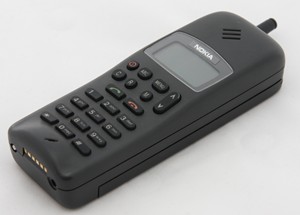
The change to digital.

Nokia 1011 - Nokia's first 2G phone.
image ©Nokia2G initiated the move to digital technology from the original analogue technology. This allows for greater network capacity. Being a digital network allowed the operators to add more (some) security to the network. The emphasis was still on the phone network, on phone services, with the only devices connected to the 2G network, initially, being mobile phones. The GSM network architecture was introduced with 2G and this still forms the basis of later generations of the mobile phone network.
As well as phone services, a simple SMS messaging was available. This used the spare capacity on the network control channel to send messages. Originally by network technicians to communicate, SMS was provided to customers to give them a second and different messaging mechanism that had not been seen before.
Data was also supported but initially as a dial-up connection on the phone system. The user could have a phone call or send data but not both. Speeds were measured in Kbps rather than the Mbps. The Internet was available but very slow, arguably not much different to home Internet at the time.
Later, as data became more important, enhancements were made to 2G. Most notably GPRS where a separate packet switched always-on network for data was introduced. Later enhancements to this network included Edge technology. By this time 2G was a respectible network but too slow for the modern user
In the UK there were four 2G networks (Vodafone, O2, Orange and T-Mobile). These operators still maintain a 2G network today. This provides a back up phone system when 4G calling is not available in areas of difficult coverage. 2G is also currently used for many iot applications most notably the communications associated with smart meters; but also alarms, health sensors, weather recording, parking machines and traffic lights.
© mobilephonetechnology.co.uk all rights reserved 2017-2025
